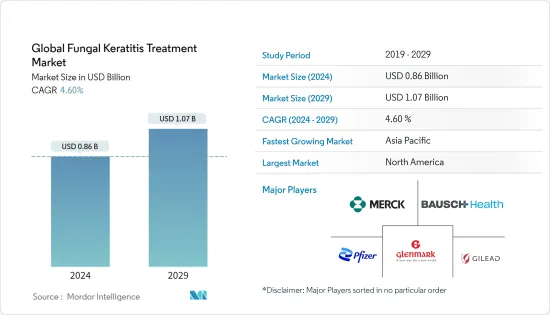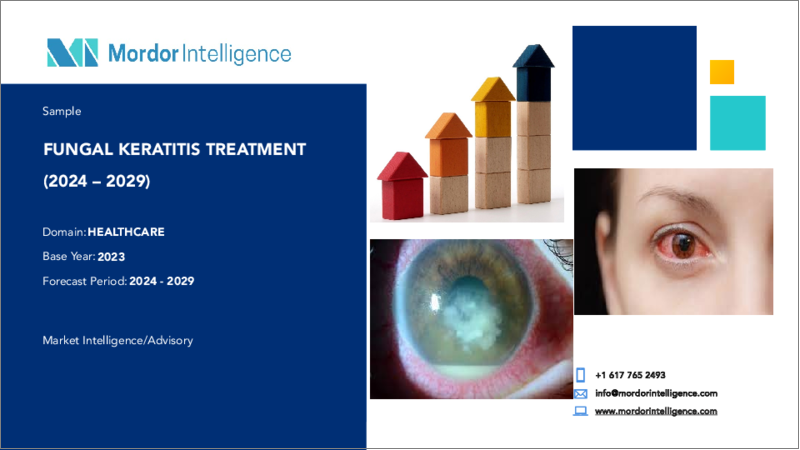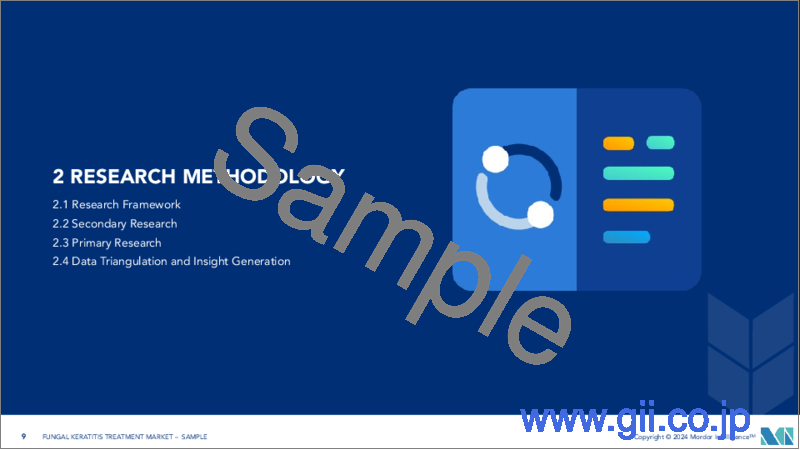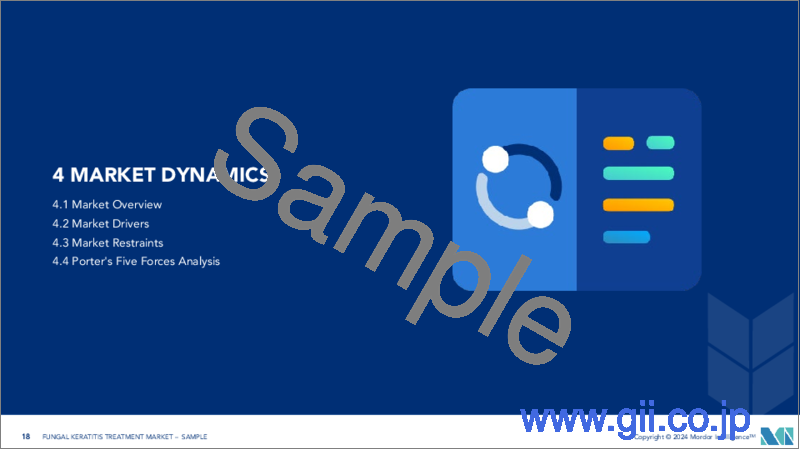|
|
市場調査レポート
商品コード
1435210
真菌性角膜炎治療:世界市場シェア分析、産業動向と統計、成長予測(2024年~2029年)Global Fungal Keratitis Treatment - Market Share Analysis, Industry Trends & Statistics, Growth Forecasts (2024 - 2029) |
||||||
|
● お客様のご希望に応じて、既存データの加工や未掲載情報(例:国別セグメント)の追加などの対応が可能です。 詳細はお問い合わせください。 |
|||||||
| 真菌性角膜炎治療:世界市場シェア分析、産業動向と統計、成長予測(2024年~2029年) |
|
出版日: 2024年02月15日
発行: Mordor Intelligence
ページ情報: 英文 119 Pages
納期: 2~3営業日
|
- 全表示
- 概要
- 目次
世界の真菌性角膜炎治療市場規模は、2024年に8億6,000万米ドルと推定され、2029年までに10億7,000万米ドルに達すると予測されており、予測期間(2024年から2029年)中に4.60%のCAGRで成長します。

新型コロナウイルス感染症(COVID-19)のパンデミックは、真菌性角膜炎治療市場の成長に大きな影響を与えると予想されます。パンデミックの発生により、研究開発活動に携わる主要企業のほとんどが医薬品開発に関連する臨床試験を中止しました。さらに、2020年3月、疾病管理予防センターと米国眼科学会は、眼科医を含む医師に対し、適切な個人用保護具の使用を前提としつつ、対面診療を緊急患者に限定するよう勧告しました。また、米国では眼科受診が初期に80%近く減少し、6月中旬の時点でも眼科受診は累積で40%減少していると推定されています。これは調査対象の市場に悪影響を与える可能性があります。
真菌性角膜炎の負担の増大と製品開発は、真菌性角膜炎治療市場の成長を促進すると予想されます。 2021年1月に発表された論文「真菌性角膜炎の世界疫学とその結果」によると、研究者らは世界の真菌性角膜炎の年間発生率は約100万人で、患者の8%から11%が片目を失うと推定しています。真菌性角膜炎に関連する危険因子は、外傷、コンタクトレンズの使用、局所コルチコステロイドの使用、糖尿病、および低い社会経済的地位です。偶発的な眼の外傷は間違いなく真菌性角膜炎の最も一般的な危険因子です。さらに、真菌性角膜炎の新しい治療法を開発および発見するためにいくつかの取り組みが行われています。たとえば、2018年9月、インドのLVプラサド眼科研究所は、無作為化二重マスク臨床試験による、真菌性角膜炎における5%ナタマイシンと1%ボリコナゾールの併用治療に関する第2相/第3相試験を完了しました。同調査機関は2021年に第IV相試験を開始する可能性が高いです。したがって、このような試験の良好な結果は、今後の市場の成長を促進する可能性が高い新しい治療法をもたらす可能性があります。
また、2021年現在、インドのAravind Eye Care Systemは、真菌性角膜炎におけるコラーゲン架橋の視覚的および臨床的転帰を評価するために、局所抗真菌療法を用いたランダム化対照試験を調査しています。この研究は、穿孔の予防と治癒プロセスの促進における非解決性真菌性角膜炎における角膜架橋の役割を見つけることを目的としています。したがって、前述の要因により、調査された市場は市場の成長に貢献すると予想されます。しかし、製品の特許の喪失と真菌性角膜炎治療薬の副作用により、今後数年間の市場の成長が妨げられる可能性があります。
真菌性角膜炎治療市場の動向
局所分野は、予測期間中に真菌性角膜炎治療市場で大幅な成長率を示すと予想されます
局所抗真菌薬は、市販されているか、全身用製剤から点眼剤に配合されていて、真菌性角膜炎の管理に主に使用される薬剤です。ナタマイシンは、真菌性角膜炎の治療用に承認された唯一の局所抗真菌製剤です。しかし、ナタマイシンは眼への浸透性が低いため、主に表在角膜感染症の場合に役立ちます。アムホテルシンBは、全身投与には副作用が伴うため、主に局所投与で使用されます。非経口製剤を再構成して調製した0.15%溶液として通常使用されます。カンジダ性角膜炎の代表的な薬剤です。フルコナゾールの誘導体であるボリコナゾール(VCZ)は、局所用および経口用の製剤で入手できます。ただし、経口ボリコナゾールは真菌感染症に対して承認されており、1%局所溶液は適応外使用です。また、局所抗真菌薬とともに、局所タクロリムスなどの免疫抑制薬が真菌性角膜炎を含む真菌感染症の補助療法として使用されます。さらに、技術の進歩と試験の増加に伴い、薬剤溶出コンタクトレンズなどの新しい標的を絞った配送の魅力が高まっています。局所薬は真菌性角膜炎に対して効果的ですが、眼への浸透性が低いことが市場の主な制約になっています。一方、新しい局所製剤が開発され、真菌性角膜炎に対して唯一承認された薬剤であることから、局所投与経路は今後も大幅な成長を続けると予想されます。
北米は市場で重要なシェアを保持すると予想されており、予測期間にも同様のシェアを獲得すると予想されます
真菌性角膜炎の症例の増加と真菌性角膜炎の治療における新たな動向により、北米が真菌性角膜炎治療市場を独占すると予想されています。米国は、真菌性角膜炎患者数の増加とその他の慢性眼疾患に加え、研究開発支出の増加により、予測期間を通じて北米地域の真菌性角膜炎治療市場全体を支配すると予想されています。米国では、真菌性角膜炎は湿気の多い暖かい地域で非常に一般的です。 2020年10月に発表された「真菌性角膜炎の世界の発生率と診断」と題された研究によると、米国南部は他の地域と比べて真菌性角膜炎の有病率が高いことがわかっています。さらに、経済協力開発機構(OECD)によると、2019年の米国のヘルスケア支出総額は3兆6,341億米ドルでした。研究開発支出の増加と大手企業の存在により、需要が拡大する可能性があります。真菌性角膜炎の病態生理学を理解するためにいくつかの研究が実施されており、この地域で研究されている市場を助けることが期待されています。例えば、2020年6月に米国眼科誌に掲載された研究では、内皮角膜形成術の際にドナー縁組織に真菌培養陽性が見られると、患者が真菌性角膜炎を発症する主要な危険因子となる可能性があることが明らかになった。このような研究では、研究対象の市場にプラスの影響を与えることが期待される適切な予防治療戦略の必要性が生じます。現在、糸状菌による真菌性角膜炎の第一選択治療としてFDAが承認した唯一の抗真菌薬は、ノバルティス社が開発したナタシン(ナタマイシン点眼液 5%)です。 2019年10月、ナタシンはノバルティスからアイヴァンス・ファーマシューティカルズに買収されました。したがって、上記のすべての要因が、予測期間中にこの地域の市場の成長を促進すると予想されます
真菌性角膜炎治療業界の概要
真菌性角膜炎治療市場の競争は中程度です。市場シェアの点では、現在市場を独占している大手企業はほとんどありません。現在市場を独占している企業には、Pfizer Inc.、Leadiant Biosciences、Gilead Biosciences, Inc.、Bausch Health、Novo Holdings A/S(Xellia Pharmaceuticals)、Alvogen、Merck &Co. Inc.などがあります。これらの企業は進化しています。競争市場での地位を確保するための研究開発活動への投資とともに、合併と買収、コラボレーション、パートナーシップなどのさまざまな戦略を通じて。例えば、2019年10月、アイヴァンス・ファーマシューティカルズは、ノバルティス社からTOBRADEX ST(トブラマイシン/デキサメタゾン点眼液)0.3%/0.05%およびNATACYN(ナタマイシン点眼液)5%を買収したと発表しました。
その他の特典
- エクセル形式の市場予測(ME)シート
- 3か月のアナリストサポート
目次
第1章 イントロダクション
- 調査の前提条件と市場定義
- 調査範囲
第2章 調査手法
第3章 エグゼクティブサマリー
第4章 市場力学
- 市場概要
- 市場促進要因
- 真菌性角膜炎疾患の負担増
- 研究開発の活発化
- 市場抑制要因
- 真菌性角膜炎治療薬に関連する特許の喪失と副作用
- ポーターのファイブフォース分析
- 新規参入業者の脅威
- 買い手/消費者の交渉力
- 供給企業の交渉力
- 代替品の脅威
- 競争企業間の敵対関係の強さ
第5章 市場セグメンテーション
- 投与経路別
- 経口
- 注射
- 局所
- 流通チャネル別
- 病院
- ドラッグストア
- その他
- 地域別
- 北米
- 米国
- カナダ
- メキシコ
- 欧州
- ドイツ
- 英国
- フランス
- イタリア
- スペイン
- その他欧州
- アジア太平洋
- 中国
- 日本
- インド
- オーストラリア
- 韓国
- その他アジア太平洋地域
- 中東・アフリカ
- GCC
- 南アフリカ
- その他中東とアフリカ
- 南米
- ブラジル
- アルゼンチン
- その他南米
- 北米
第6章 競合情勢
- 企業プロファイル
- Alvogen
- Bausch Health
- Gilead Biosciences, Inc.
- Glenmark Pharmaceuticals
- Leadiant Biosciences
- Merck & Co. Inc.
- Aurolab
- Eyevance Pharmaceuticals LLC
- Novo Holdings A/S(Xellia Pharmaceuticals)
- Pfizer Inc.
第7章 市場機会と今後の動向
The Global Fungal Keratitis Treatment Market size is estimated at USD 0.86 billion in 2024, and is expected to reach USD 1.07 billion by 2029, growing at a CAGR of 4.60% during the forecast period (2024-2029).

The COVID-19 pandemic is anticipated to impact the growth of the Fungal Keratitis Treatment market significantly. The outbreak of pandemic has led most of the major players involved in research and development activities to halt the clinical trials related to drug development. Additionally, in March 2020, the Centers for Disease Control and Prevention and the American Academy of Ophthalmology recommended that physicians, including ophthalmologists, should limit in-person care to urgent and emergent patients while assuming the use of appropriate personal protective equipment. Also, it is estimated that there was a nearly 80% initial decrease in ophthalmology visits and that as of mid-June there was still a cumulative decrease in ophthalmology visits of 40% in the United States. This is likely to have a negative impact on the market studied.
The growing burden of fungal keratitis and product development is expected to fuel the fungal keratitis treatment market growth. According to the article 'Global Epidemiology of Fungal Keratitis and Its Outcomes' published in January 2021, researchers estimated that the annual global incidence of fungal keratitis to be approximately 1 million cases, with 8% to 11% of patients losing an eye. The risk factors associated with fungal keratitis are trauma, contact lens use, topical corticosteroid use, Diabetes mellitus, and low socioeconomic status. Incidental ocular trauma is undoubtedly the most common risk factor for fungal keratitis. Additionally, several efforts are being made to develop and find new therapeutics for fungal keratitis. For instance, in September 2018, L.V. Prasad Eye Institute, India completed the Phase 2/Phase 3 study on Combination Treatment of 5% Natamycin and 1% Voriconazole in Fungal Keratitis with the randomized double-masked clinical trial. The research institute is likely to initiate the Phase IV trials in 2021. Thus, the positive outcomes of such trials may result in a new treatment that is likely to boost the market growth in the upcoming period.
Also, as of 2021, Aravind Eye Care System, India is investigating a randomized control trial with topical anti-fungal therapy to assess the visual and clinical outcomes of collagen cross-linking in fungal keratitis. The study is aimed at finding the role of corneal cross-linking in non-resolving fungal keratitis in the prevention of perforation and enhancement of the healing process Thus, owing to the aforementioned factors, the studied market is expected to contribute to the market growth, however, loss of patents of product and side effects of the fungal keratitis treatment is likely to hinder the growth of the market over upcoming years.
Fungal Keratitis Treatment Market Trends
Topical Segment is Expected to Show a Significant Growth Rate in the Fungal Keratitis Treatment Market Over the Forecast Period
The Topical antifungals, either commercially available or compounded from systemic preparation into eye-drops are the majorly used drugs for the management of fungal keratitis. Natamycin is the only approved topical antifungal preparation for the treatment of fungal keratitis. However, due to the poor ocular penetration, natamycin is primarily been useful in cases with superficial corneal infection. Amphotercin B is majorly used by the topical route as systemic administration is associated with adverse effects. It is commonly used as a 0.15% solution prepared by reconstituting the parenteral formulation. It is the drug of choice for Candida keratitis. Voriconazole (VCZ), a derivative of fluconazole, is available in topical and oral formulations. However, oral voriconazole is approved for fungal infections, 1% topical solution is an off-label use. Also, along with the topical antifungals, immunosuppressants such as topical tacrolimus are employed as adjuvant therapy in fungal infections including fungal keratitis. Moreover, with the growing technological advancements and trials, the new targeted deliveries such as drug-eluting contact lenses are growing attraction. Topical drugs are effective against fungal keratitis, however, poor ocular penetration is the primary restraint in the market. On the other hand, with the development of the new topical formulations and being the only approved medication for fungal keratitis, the topical route of administration is expected to hold significant growth over the period.
North America is Expected to Hold a Significant Share in the Market and Expected to do Same in the Forecast Period
North America is expected to dominate the fungal keratitis treatment market owing to increasing cases of fungal keratitis and emerging trends in the treatment of fungal keratitis. The United States is expected to dominate the overall fungal keratitis treatment market in the North American region, throughout the forecast period, due to the increasing number of fungal keratitis patients, and other chronic eye conditions, along with rising research and development expenditure. In the United States, fungal keratitis is quite common in humid and warm regions. As per the study titled, '' The global incidence and diagnosis of fungal keratitis'', published in October 2020, the southern part of the United States have a higher prevalence of fungal keratitis as compared to other regions. Furthermore, according to the Organization for Economic Co-operation and Development (OECD) in 2019, total healthcare spending in the United States was USD 3,634.1 billion. The rising research and development expenditures and the presence of major players may result in the growth of demand. Several studies are being conducted to understand the pathophysiology for fungal keratitis which is expected to aid the market studied in this region. For instance, a study published in the American Journal of Ophthalmology, in June 2020, revealed that a positive fungal culture on the donor rim tissue during the time of endothelial keratoplasty can be a major risk factor for developing fungal keratitis in the patients. Such studies arise the need for proper preventative treatment strategies which is expected to positively impact the market studied. Currently, the only FDA-approved anti-fungal drug as the first line of treatment for fungal keratitis caused by filamentous fungi is Natacyn (natamycin ophthalmic suspension 5%) developed by Novartis. In October 2019, the Natacyn was acquired by Eyevance Pharmaceuticals from Novartis. Hence, all the above-mentioned factors are expected to boost the market growth in the region during the forecast period
Fungal Keratitis Treatment Industry Overview
The Fungal Keratitis Treatment Market is moderately competitive. In terms of market share, few of the major players are currently dominating the market. Some of the companies which are currently dominating the market are Pfizer Inc., Leadiant Biosciences, Gilead Biosciences, Inc., Bausch Health, Novo Holdings A/S (Xellia Pharmaceuticals), Alvogen, and Merck & Co. Inc. The companies are evolving through various strategies such as mergers and acquisitions, collaborations, and partnerships, along with investment in research and development activities to secure the position in the competitive market. For instance, in October 2019, Eyevance Pharmaceuticals announced the acquisition of TOBRADEX ST (tobramycin/dexamethasone ophthalmic suspension) 0.3%/0.05% and NATACYN (natamycin ophthalmic suspension) 5% from Novartis.
Additional Benefits:
- The market estimate (ME) sheet in Excel format
- 3 months of analyst support
TABLE OF CONTENTS
1 INTRODUCTION
- 1.1 Study Assumptions and Market Definition
- 1.2 Scope of the Study
2 RESEARCH METHODOLOGY
3 EXECUTIVE SUMMARY
4 MARKET DYNAMICS
- 4.1 Market Overview
- 4.2 Market Drivers
- 4.2.1 Growing Burden of Fungal Keratitis Disease
- 4.2.2 Increasing Research and Development Activities
- 4.3 Market Restraints
- 4.3.1 Loss of Patents and Side Effects Associated with Fungal Keratitis Treatment Drugs
- 4.4 Porter's Five Force Analysis
- 4.4.1 Threat of New Entrants
- 4.4.2 Bargaining Power of Buyers/Consumers
- 4.4.3 Bargaining Power of Suppliers
- 4.4.4 Threat of Substitute Products
- 4.4.5 Intensity of Competitive Rivalry
5 MARKET SEGMENTATION
- 5.1 By Route of Administration
- 5.1.1 Oral
- 5.1.2 Injection
- 5.1.3 Topical
- 5.2 By Distribution Channel
- 5.2.1 Hospitals
- 5.2.2 Drug Stores
- 5.2.3 Others
- 5.3 Geography
- 5.3.1 North America
- 5.3.1.1 United States
- 5.3.1.2 Canada
- 5.3.1.3 Mexico
- 5.3.2 Europe
- 5.3.2.1 Germany
- 5.3.2.2 United Kingdom
- 5.3.2.3 France
- 5.3.2.4 Italy
- 5.3.2.5 Spain
- 5.3.2.6 Rest of Europe
- 5.3.3 Asia-Pacific
- 5.3.3.1 China
- 5.3.3.2 Japan
- 5.3.3.3 India
- 5.3.3.4 Australia
- 5.3.3.5 South Korea
- 5.3.3.6 Rest of Asia-Pacific
- 5.3.4 Middle East and Africa
- 5.3.4.1 GCC
- 5.3.4.2 South Africa
- 5.3.4.3 Rest of Middle East and Africa
- 5.3.5 South America
- 5.3.5.1 Brazil
- 5.3.5.2 Argentina
- 5.3.5.3 Rest of South America
- 5.3.1 North America
6 COMPETITIVE LANDSCAPE
- 6.1 Company Profiles
- 6.1.1 Alvogen
- 6.1.2 Bausch Health
- 6.1.3 Gilead Biosciences, Inc.
- 6.1.4 Glenmark Pharmaceuticals
- 6.1.5 Leadiant Biosciences
- 6.1.6 Merck & Co. Inc.
- 6.1.7 Aurolab
- 6.1.8 Eyevance Pharmaceuticals LLC
- 6.1.9 Novo Holdings A/S (Xellia Pharmaceuticals)
- 6.1.10 Pfizer Inc.




